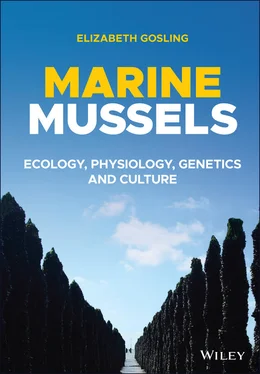
Figure 1.4 Different external shell forms in the family Mytilidae. (A) Mytiliform Mytilus galloprovincialis .
Source: From MgA. Jiří Novák (biolib.cz).
(B) Modioliform Modiolus lulat .
Source: From MgA. Jiří Novák (biolib.cz).
(C) Elongate coral boring form Lithophaga lithophaga .
Source: From MgA. Jiří Novák (biolib.cz).
(D) Shell with pronounced anterior and posterior radiating ribs, as in Musculus niger .
Source: From Guido Poppe © G. & Ph. Poppe ( http://www.poppe‐images.com/).
(E) Radiating sculpture over entire shell surface, as in Brachidontes erosus .
Source: From MgA. Jiří Novák (biolib.cz).
(F) Perna viridis .
Source: From Guido Poppe © G. & Ph. Poppe ( http://www.poppe‐images.com/) ( See colour plate section for colour representation of this figure ).
Significant Evolutionary Developments in the Family Mytilidae
As already mentioned, one of the most significant developments in bivalve evolution was the emergence of the heteromyarian form, possibly from a putative isomyarian infaunal ancestor ( Figures 1.3and 1.5A). The form – most pronounced in the Mytilidae – when coupled with secure byssal attachment allowed mussels to anchor themselves and live in high population densities in wave‐exposed habitats (Morton 1996). Species of Mytilidae that exhibit varying degrees of heteromyarianism are found in the subfamilies Arcuatulinae, Brachidontinae, Mytilinae, Modiolinae, Musculinae, Septiferinae and Limnoperninae. Infaunal (endobyssate) mytilids inhabit both hard and soft substrates and are less heteromyarian, but more diverse, than epifaunal (epibyssate) rocky shore mytilids. The most significant adaptation in infaunal mytilids is a shell that is long and narrow (modioliform), allowing large numbers of individuals to form dense beds. The following text is heavily reliant on Morton (1992).
The posteriorly elongated shell keeps the inhalant and exhalant orifices in these fixed bivalves above the sediment water interface ( Figure 1.5B). Enlargement of the posterior face of the shell and reduction of the anterior has resulted in the development of larger posterior adductor and posterior byssal retractor muscles and reduced anterior adductor and anterior byssal retractor muscles. In Perna , the anterior adductor muscle has been lost entirely, making the genus the only monomyarian one that has retained the heteromyarian form (Morton 1987). In addition, there has been an enlargement of the ligament, which probably acts to keep the two shell valves correctly aligned, particularly since another consequence of heteromyarianism is either a large reduction in hinge plate and teeth or their loss. Another adaptive feature, exemplified by species of Musculista , Modiolus and Arcuatula , is a thin, brittle shell that provides sufficient protection for an attached, infaunal lifestyle. Epibyssate mytilids (e.g. Septifer and Brachidontes ) have much thicker sculptured shells that help to withstand the effects of wave action and provide protection against predatory snails, crabs and birds. To enhance stability around the point of byssal attachment, the antero‐ventral region of the shell valves is flattened, both laterally and antero‐posteriorly. Flattening of the shell provides greater stability on wave exposed shores by opposing an overturning force and lowering the centre of gravity, thereby reducing the effects of drag. Such an adaptation is clearly associated with the full expression of heteromyarianism and thus the successful colonisation of hard subtrates ( Figure 1.5C). For some mytilids (e.g. Mytilus spp.), however, this adaptation has released them from a colonial life, and some (e.g. Septifer bilocularis ) are completely solitary. Ventral flattening also resulted in development of the umbones into ‘beaks’, which, with the progressive assumption of the heteromyarian form, are located in a subterminal position beyond the reduced anterior edge of the shell. There are a few points worth noting. In infaunal habitats, some species (e.g. Brachiodontes erosus ) possess a cyclindrical shell, but the shell is more triangular and ventrally flattened when the species is epifaunal (Morton 1991). According to Morton (1970), the essential adaptations necessary in the development of the heteromyarian shell probably commenced in infaunal lineages, as a wide range of extant mytilids still possess features that adapt them for an endobyssate mode of life (e.g. a pallial sinus, an elongated modioliform shell and a smooth and often thin shell).

Figure 1.5 Lateral views (A–C) and transverse sections (A1–C1) of (A) an isomyarian, (B) a modioliform, and (C) a mytiliform bivalve; a = axis through the adductor muscles; d = the mid‐dorso‐ventral axis of the shell; h = the hinge axis; m = the mid‐dorsal and foot (byssus) axis; and w = the position of greatest shell width.
Source: From Morton (1992). Reproduced with permission from Elsevier.
The evolution of hard calcareous coral reefs in the Mesozoic (252–66 mya) was an event that foresaw important phases of molluscan adaptive radiation (Morton 1990). In the family Mytilidae, borers of coral skeletons, rock and even wood constitute an excellent example of such a radiation. The evolution of gastropod predators is regarded as the driving force for coral–bivalve associations (Morton 1990). Exploitation of living coral as a habitat was facilitated by the evolution of larval adaptations, enabling them to penetrate living coral tissue and thereby develop mechanisms to overcome coral defences (Morton 1990). The boring life habit developed independently in both epifaunal and infaunal ancestors and also in at least five other families of clams: Gastrochaenidae, Petricolidae, Pholadidae, Clavagellidae and Tridacnidae (references in Ockelmann & Dinesen 2009). In the Mytilidae there are about 78 species of borers in six genera: Adula (7 species), Botula (6), Fungiacava (1), Gregariella (17), Leiosolenus (36) and Lithophaga (11). The majority of species use chemical means to bore into calcareous rocks or corals, while Adula and Botula , for example, are mechanical borers in softer clay and chalk (Kleemann 1990). The boring habit was made possible by the elongated shell as seen in Adula , Botula and Lithophaga , which probably evolved from a heteromyarian ancestor like Modiolus (Kleemann 1990). The exceptionally long shell ligament in the Mytilidae, with its consequent powerful opening thrust, represents another preconditioning factor that made boring possible. Coevolution between some borers and certain living corals has been suggested (Mokady et al . 1994).
In the chemical borer Lithophaga , the dorsal extension of the mantle edges was accompanied by increased mucus secretion to aid in cleansing. Protrusion of these tissues, and direct application by them of the mucous, provided the means of chemical boring (Kleemann 1990). Initially, the mucous was believed to be acidic, but histochemical tests have since shown that the secretion is a neutral mucoprotein with calcium‐binding ability. This finding indicates that in Lithophaga the complexing of calcium by the secretion of the pallial glands is the mechanism of chemical boring into calcareous rock (Jaccarini et al . 1968). The boring glands in the Lithophaga may be derived from the cocoon‐forming cells of a nest‐building bivalve like Arcuatula (Morton 1982). According to Yonge (1955), all boring in the Mytilidae was initially mechanical. In mechanical borers such as Botula and Adula , firm attachment is made by byssal threads arranged in a large anterior and a small posterior group. These threads are much more numerous but less localised than in chemical borers. Noncalcareous rock is abraded by the dorsal surfaces of the valves, which are deeply eroded. The posterior byssal retractors and the exceptionally long ligament provide the force needed for boring. The former deepens the boring by forcing the anterior end of the shell against the rock, while the latter widens it by forcing apart the shell valves.
Читать дальше














